Degradation Characteristics of Soil-Quality-Related Physical and Chemical Properties Affected by Collapsing Gully: The Case of Subtropical Hilly Region, China
Abstract
1. Introduction
2. Materials and Methods
2.1. Study Area and Description of Collapsing Gullies
2.2. Soil Sampling and Laboratory Measurement
2.3. Assessment of Soil Quality Index (SQI)
2.4. Statistical Analysis
3. Results
3.1. Soil Physical and Chemical Indicators under Different Collapsing Gullies and Non-Erosion Slopes
3.2. Soil Physical and Chemical Indicators at Different Spatial Locations of Collapsing Gullies
3.3. Assessment of SQI according to PCA
3.4. Key Indicators Associated with Collapsing Gullies and Spatial Locations
4. Discussion
4.1. Soil Properties in Different Collapsing Gullies
4.2. Effects of Spatial Position on Soil Properties in the Collapsing Gully
4.3. SQI and Key Indicators
5. Conclusions
Author Contributions
Funding
Conflicts of Interest
References
- Morgan, R.P.C. Soil Erosion and Conservation; John Wiley & Sons: New Jersey, NJ, USA, 2015. [Google Scholar]
- Boardman, J. Soil erosion science: Reflections on the limitations of current approaches. Catena 2006, 68, 73–86. [Google Scholar] [CrossRef]
- Betts, H.D.; De Rose, R.C. Digital elevation models as a tool for monitoring and measuring gully erosion. Int. J. Appl. Earth Obs. Geoinf. 1999, 1, 91–101. [Google Scholar] [CrossRef]
- Poesen, J.; Nachtergaele, J.; Verstraeten, G.; Valentin, C. Gully erosion and environmental change: Importance and research needs. Catena 2003, 50, 91–133. [Google Scholar] [CrossRef]
- Zgłobicki, W.; Poesen, J.; Cohen, M.; Del Monte, M.; García-Ruiz, J.M.; Ionita, I.; Niacsu, L.; Machová, Z.; Martín-Duque, J.F.; Nadal-Romero, E.; et al. The Potential of Permanent Gullies in Europe as Geomorphosites. Geoheritage 2019, 11, 217–239. [Google Scholar] [CrossRef]
- Zeng, Z.X. Observation collapse erosion development and its control in Baoliu landscape. Soil Water Conserv. Fujian 1992, 1, 18–23. [Google Scholar]
- Chen, X.A.; Yang, J.; Xiong, Y.; Xiao, S.S. Research on the soil characteristics and factors of collapsing erosion in the red soil zone. J. Hydraul. Eng. 2013, 44, 1175–1181. [Google Scholar]
- Xu, J.X. Benggang erosion: The influencing factors. Catena 1996, 27, 249–263. [Google Scholar]
- Jiang, F.S.; Huang, Y.H.; Wang, M.K.; Lin, J.S.; Zhao, G.; Ge, H.L. Effects of rainfall intensity and slope gradient on steep colluvial deposit erosion in Seast China. Soil Sci. Soc. Am. J. 2014, 78, 1741–1752. [Google Scholar] [CrossRef]
- Lin, J.S.; Huang, Y.H.; Wang, M.K.; Jiang, F.S.; Zhang, X.B.; Ge, H.L. Assessing the sources of sediment transported in gully systems using a fingerprinting approach: An example from South-east China. Catena 2015, 129, 9–17. [Google Scholar] [CrossRef]
- Lin, J.S.; Huang, Y.H.; Zhao, G.; Jiang, F.S.; Wang, M.K.; Ge, H.L. Flow-driven soil erosion processes and the size selectivity of eroded sediment on steep slopes using colluvial deposits in a permanent gully. Catena 2017, 157, 47–57. [Google Scholar] [CrossRef]
- Zhang, X.J. The practice and prospect of hill collapsing improving and development in southern China. Water Resour. 2010, 4, 17–22. [Google Scholar]
- Zhong, B.; Peng, S.; Zhang, Q.; Ma, H.; Cao, S. Ecological economics for the restoration of collapsing gullies in Southern China. Land Use Policy 2013, 32, 119–124. [Google Scholar] [CrossRef]
- Xia, J.W.; Cai, C.F.; Wei, Y.J.; Wu, X.L. Granite residual soil properties in collapsing gullies of south China: Spatial variations and effects on collapsing gully erosion. Catena 2019, 174, 469–477. [Google Scholar] [CrossRef]
- Luk, S.H.; Yao, Q.Y.; Gao, J.Q.; Zhang, J.Q.; He, Y.G.; Huang, S.M. Environmental analysis of soil erosion in Guangdong Province: A Deqing case study. Catena 1997, 29, 97–113. [Google Scholar] [CrossRef]
- Liang, Y.; Ning, D.H.; Pan, X.Z. The red soil region of Southern landfall erosion characteristics and treatment of. J. Soil Water Conserv. 2009, 1, 31–34. [Google Scholar]
- Jiang, F.S.; Zhan, Z.Z.; Chen, J.L.; Lin, J.S.; Wang, M.K.; Ge, H.L. Rill erosion processes on a steep colluvial deposit slope under heavy rainfall in flume experiments with artificial rain. Catena 2018, 169, 46–58. [Google Scholar] [CrossRef]
- Deng, Y.S.; Cai, C.F.; Xia, D.; Ding, S.W.; Chen, J.Z.; Wang, T.W. Soil Atterberg limits of different weathering profiles of the collapsing gullies in the hilly granitic region of southern China. Solid Earth 2017, 8, 499–513. [Google Scholar] [CrossRef]
- Tao, Y.; He, Y.B.; Duan, X.Q.; Zou, Z.Q.; Lin, L.R.; Chen, J.Z. Preferential flows and soil moistures on a Benggang slope: Determined by the water and temperature co-monitoring. J. Hydrol. 2017, 553, 678–690. [Google Scholar] [CrossRef]
- Wei, Y.J.; Wu, X.L.; Li, X.Y.; Xia, J.W.; Cai, C.F.; Hassanikhah, A. A novel and facile method for characterizing shrinkage geometry along the granitic soil profile. Soil Sci. Soc. Am. J. 2018, 82, 20–30. [Google Scholar] [CrossRef]
- Xia, D.; Deng, Y.S.; Wang, S.L.; Ding, S.W.; Cai, C.F. Fractal features of soil particle-size distribution of different weathering profiles of the collapsing gullies in the hilly granitic region, South China. Nat. Hazards 2015, 79, 455–478. [Google Scholar] [CrossRef]
- Chen, J.L.; Zhou, M.; Lin, J.S.; Jiang, F.S.; Huang, B.F.; Xu, T.T.; Wang, M.K.; Ge, H.L.; Huang, Y.H. Comparison of soil physicochemical properties and mineralogical compositions between non-collapsible soils and collapsed gullies. Geoderma 2018, 317, 56–66. [Google Scholar] [CrossRef]
- Deng, Y.S.; Xia, D.; Cai, C.F.; Ding, S.W. Effects of land uses on soil physic-chemical properties and erodibility in collapsing-gully alluvial fan of Anxi County, China. J. Integr. Agric. 2016, 15, 1863–1873. [Google Scholar] [CrossRef]
- Xu, M.; Zhao, Y.; Liu, G.; Wilson, G.V. Identification of soil quality factors and indicators for the Loess Plateau of China. Soil Sci. 2006, 171, 400–413. [Google Scholar]
- Tang, W.; Liu, H.; Liu, B. Effects of gully erosion and gully filling on soil degradation in the black soil region of Northeast China. J. Mt. Sci. 2013, 10, 913–922. [Google Scholar] [CrossRef]
- Ollobarren, P.; Capra, A.; Gelsomino, A.; Spada, C.L. Effects of ephemeral gully erosion on soil degradation in a cultivated area in Sicily (Italy). Catena 2016, 145, 334–345. [Google Scholar] [CrossRef]
- Xu, M.; Li, Q.; Wilson, G. Degradation of soil physicochemical quality by ephemeral gully erosion on sloping cropland of the hilly Loess Plateau, China. Soil Tillage Res. 2016, 155, 9–18. [Google Scholar] [CrossRef]
- Capra, A.; Porto, P.; Scicolone, B. Relationships between rainfall characteristics and ephemeral gully erosion in a cultivated catchment in Sicily (Italy). Soil Tillage Res. 2009, 105, 77–87. [Google Scholar] [CrossRef]
- Qin, W.; Zhu, Q.; Zhao, L.; Kuang, G. Topographic characteristics of ephemeral gully erosion in loess hilly and gully region based on RS and GIS. Trans. CSAE 2010, 26, 58–64. [Google Scholar]
- Liu, H.U.; Zhang, T.Y.; Liu, B.Y.; Liu, G.; Wilson, G. Effects of gully erosion and gully filling on soil depth and crop production in the black soil region, northeast China. Environ. Earth Sci. 2013, 68, 1723–1732. [Google Scholar] [CrossRef]
- Paz-Ferreiro, J.; Fu, S. Biological Indices for Soil Quality Evaluation: Perspectives and Limitations. Land Degrad. Dev. 2016, 27, 14–25. [Google Scholar] [CrossRef]
- Bone, J.; Barraclough, D.; Eggleton, P.; Head, M.; Jones, D.T.; Voulvoulis, N. Prioritising soil quality assessment through the screening of sites: The use of publicly collected data. Land Degrad. Dev. 2014, 25, 251–266. [Google Scholar] [CrossRef]
- Pulido Moncada, M.; Gabriels, D.; Cornelis, W.; Lobo, D. Comparing aggregate stability tests for soil physical quality indicators. Land Degrad. Dev. 2015, 26, 843–852. [Google Scholar] [CrossRef]
- Griffiths, B.S.; Ball, B.C.; Daniell, T.J.; Hallett, P.D.; Neilson, R.; Wheatley, R.E.; Osler, G.; Bohanec, M. Integrating soil quality changes to arable agricultural systems following organic matter addition, or adoption of a ley-arable rotation. Appl. Soil Ecol. 2010, 46, 43–53. [Google Scholar] [CrossRef]
- Andrews, S.S.; Karlen, D.L.; Mitchell, J.P. A comparison of soil quality indexing methods for vegetable production systems in northern California. Agric. Ecosyst. Environ. 2002, 90, 25–45. [Google Scholar] [CrossRef]
- Andrews, S.S.; Karlen, D.L.; Cambardella, C.A. The soil management assessment framework: A quantitative soil quality evaluation method. Soil Sci. Soc. Am. J. 2004, 68, 1945–1962. [Google Scholar] [CrossRef]
- Mandal, U.K.; Warrington, D.N.; Bhardwaj, A.K.; Bar-Tal, A.; Kautsky, L.; Minz, D.; Levy, G.J. Evaluating impact of irrigation water quality on a calcareous clay soil using principal component analysis. Geoderma 2008, 144, 189–197. [Google Scholar] [CrossRef]
- Vasu, D.; Singh, S.K.; Ray, S.K.; Duraisami, V.P.; Tiwary, P.; Chandran, P.A.; Nimkar, M.; Anantwar, S.G. Soil quality index (SQI) as a tool to evaluate crop productivity in semi-arid Deccan plateau, India. Geoderma 2016, 282, 70–79. [Google Scholar] [CrossRef]
- Raiesi, F. A minimum data set and soil quality index to quantify the effect of land use conversion on soil quality and degradation in native rangelands of upland arid and semiarid regions. Ecol. Indic. 2017, 75, 307–320. [Google Scholar] [CrossRef]
- Vincent, D.P.O.; Lal, R. Towards a standard technique for soil quality assessment. Geoderma 2016, 265, 96–102. [Google Scholar]
- Zhang, Y.H.; Xu, X.L.; Li, Z.W.; Liu, M.X.; Xu, C.H.; Zhang, R.F.; Luo, W. Effects of vegetation restoration on soil quality in degraded karst landscapes of southwest China. Sci. Total Environ. 2019, 650, 2657–2665. [Google Scholar] [CrossRef]
- ISSAS. Soil Physical and Chemical Analysis; Shanghai Science and Technology Press: Shanghai, China, 1978. (In Chinese) [Google Scholar]
- Logsdon, S.D.; Jaynes, D.B. Methodology for determining hydraulic conductivity with tension infiltrometers. Soil Sci. Soc. Am. J. 1993, 57, 1426–1431. [Google Scholar] [CrossRef]
- Wooding, R.A. Steady infiltration from a shallow circular pond. Water Resour. Res. 2010, 4, 1259–1273. [Google Scholar] [CrossRef]
- Terzaghi, K. The shear resistance of saturated soils. Int. Conf. Soil Mech. Found. Eng. 1936, 1, 54–56. [Google Scholar]
- ASTM D3080-90. Standard Test Method for Direct Shear Test of Soils under Consolidated Drained Conditions; ASTM: West Conshohocken, PA, USA, 2004. [Google Scholar]
- Nelson, D.W. Total carbon, organic carbon and organic matter. Methods Soil Anal. 1982, 9, 961–1010. [Google Scholar]
- Horta, M.D.C.; Torrent, J. The Olsen P method as an agronomic and environmental test for predicting phosphate release from acid soils. Nutr. Cycl. Agroecosyst. 2007, 77, 283–292. [Google Scholar] [CrossRef]
- Sims, J.T. Comparison of mehlich 1 and mehlich 3 extractants for P, K, Ca, Mg, Mn, Cu and Zn in Atlantic coastal plain soils1. Commun. Soil Sci. Plant Anal. 1989, 20, 1707–1726. [Google Scholar] [CrossRef]
- Böhm, W. Methods of Studying Soot Systems; Springer: Berlin, Germany, 1979. [Google Scholar]
- Li, Q.; Xu, M.; Liu, G.; Zhao, Y.; Tuo, D. Cumulative effects of a 17-year chemical fertilization on the soil quality of cropping systemin the loess hilly region, China. J. Plant Nutr. Soil Sci. 2013, 176, 249–259. [Google Scholar] [CrossRef]
- Brejda, J.J.; Karlen, D.L.; Smith, J.L.; Allan, D.L. Identification of regional soil quality factors and indicators: II. Northern Mississippi Loess Hills and Palouse Prairie. Soil Sci. Soc. Am. J. 2000, 64, 2125–2135. [Google Scholar] [CrossRef]
- Andrews, S.S.; Mitchell, J.P.; Mancinelli, R.; Karlen, D.L.; Hartz, T.K.; Horwath, W.R.; Pettygrove, G.S.; Scow, K.M.; Munk, D.S. On-farm assessment of soil quality in California’s Central Valley. Agron. J. 2002, 94, 12–13. [Google Scholar] [CrossRef]
- Bastida, F.; Moreno, J.L.; Hernandez, T.; Garcia, C. Microbiological degradation index of soils in a semiarid climate. Soil Biol. Biochem. 2006, 38, 3463–3473. [Google Scholar] [CrossRef]
- Masto, R.E.; Chhonkar, P.K.; Singh, D.; Patra, A.K. Alternative soil quality indices for evaluating the effect of intensive cropping, fertilisation and manuring for 31 years in the semi-arid soils of India. Environ. Monit. Assess. 2008, 136, 419–435. [Google Scholar] [CrossRef] [PubMed]
- Kaiser, H.F. The Application of Electronic Computers to Factor Analysis. Educ. Psychol. Meas. 1960, 20, 141–151. [Google Scholar] [CrossRef]
- Lal, R. Soil Erosion Impact on Agronomic Productivity and Environment Quality. Crit. Rev. Plant Sci. 1998, 17, 319–464. [Google Scholar] [CrossRef]
- Jonasson, S.; Michelsen, A. Nutrient cycling in subarctic and arctic ecosystems, with special reference to the Abisko and Torneträsk region. Ecol. Bull. 1996, 45, 45–52. [Google Scholar]
- Xia, D.; Ding, S.W.; Long, L.; Deng, Y.S.; Wang, Q.X.; Wang, S.L.; Cai, C.F. Effects of collapsing gully erosion on soil qualities of farm fields in the hilly granitic region of South China. J. Integr. Agric. 2016, 12, 201–213. [Google Scholar] [CrossRef]
- Zhang, C.; Xue, S.; Liu, G.B.; Song, Z.L. A comparison of soil qualities of different revegetation types in the Loess Plateau, China. Plant Soil 2011, 347, 163–178. [Google Scholar] [CrossRef]
- Tang, G.Y.; Gao, C.J.; Li, K. Effects of vegetation restoration on the amelioration of degraded soil in a dry-hot valley. Acta Ecol. Sin. 2015, 35, 5157–5167. [Google Scholar]
- Deng, Y.S.; Cai, C.; Xia, D.; Ding, S.W.; Chen, J.Z. Fractal features of soil particle size distribution under different land-use patterns in the alluvial fans of collapsing gullies in the hilly granitic region of southern China. PLoS ONE 2017, 12, e0173555. [Google Scholar] [CrossRef]
- Geng, R.; Zhang, G.H.; Ma, Q.H.; Wang, H. Effects of landscape positions on soil resistance to rill erosion in a small catchment on the Loess Plateau. Biosyst. Eng. 2017, 160, 95–108. [Google Scholar] [CrossRef]
- Li, Z.W.; Zhang, G.H.; Geng, R.; Wang, H. Spatial heterogeneity of soil detachment capacity by overland flow at a hillslope with ephemeral gullies on the Loess Plateau. Geomorphology 2015, 248, 264–272. [Google Scholar] [CrossRef]
- Shi, Z.H.; Fang, N.F.; Wu, F.Z.; Wang, L.; Yue, B.J.; Wu, G.L. Soil erosion processes and sediment sorting associated with transport mechanisms on steep slopes. J. Hydrol. 2012, 454–455, 123–130. [Google Scholar] [CrossRef]
- De Baets, S.; Poesen, J.; Gyssels, G.; Knapen, A. Effects of grass roots on the erodibility of top soils during concentrated flow. Geomorphology 2006, 76, 54–67. [Google Scholar] [CrossRef]
- Zhang, G.H.; Tang, K.M.; Sun, Z.; Zhang, X.C. Temporal variability in rill erodibility for two types of grasslands. Soil Res. 2014, 52, 781–788. [Google Scholar] [CrossRef]
- Slobodian, N.; Rees, K.V.; Pennock, D. Cultivation induced effects on belowground biomass and organic carbon. Soil Sci. Soc. Am. J. 2002, 66, 924–930. [Google Scholar] [CrossRef]
- Kosmas, C.; Danalatos, N.G.; Gerontidis, S. The effect of land parameters on vegetation performance and degree of erosion under Mediterranean conditions. Catena 2000, 40, 3–17. [Google Scholar] [CrossRef]
- Ni, S.J.; Zhang, J.H. Variation of chemical properties as affected by soil erosion on hillslopes and terraces. Eur. J. Soil Sci. 2010, 58, 1285–1292. [Google Scholar] [CrossRef]
- Cihacek, L.J.; Swan, J.B. Effects of erosion on soil chemical properties in the north central region of the United States. J. Soil Water Conserv. 1994, 49, 259–265. [Google Scholar]
- Pan, J.; Bergsma, E. Determination of soil erosion class using soil infiltration rate and soil shear resistance. J. Soil Water Conserv. 1995, 4, 122–128. [Google Scholar]
- Pierson, F.B.; Mulla, D.J. Aggregate stability in the Palouse region of Washington: Effect of landscape position. Soil Sci. Soc. Am. J. 1990, 54, 1407–1412. [Google Scholar] [CrossRef]
- Zhang, S.; Jiang, L.; Liu, X.; Zhang, X.; Fu, S.; Dai, L. Soil nutrient variance by slope position in a Mollisol farmland area of Northeast China. Chin. Geogr. Sci. 2015, 26, 508–517. [Google Scholar] [CrossRef]
- Knapen, A.; Poesen, J.; Govers, G.; Gyssels, G.; Nachtergaele, J. Resistance of soils to concentrated flow erosion: A review. Earth Sci. Rev. 2007, 80, 75–109. [Google Scholar] [CrossRef]
- Tisdall, J.M.; Oades, J.M. Organic matter and water-stable aggregates in soils. J. Soil Sci. 1982, 33, 141–163. [Google Scholar] [CrossRef]
- Andrews, S.S.; Carroll, C.R. Designing a soil quality assessment tool for sustainable agroecosystem management. Ecol. Appl. 2001, 11, 1573–1585. [Google Scholar] [CrossRef]
- Karlen, D.L.; Hurley, E.G.; Andrews, S.S.; Cambardella, C.A.; Meek, D.W.; Duffy, M.D.; Mallarino, A.P. Crop rotation effects on soil quality at three northern corn/soybean locations. Agron. J. 2006, 98, 484–495. [Google Scholar] [CrossRef]
- Obade, V.D.P.; Lal, R. Soil quality evaluation under different land management practices. Environ. Earth Sci. 2014, 72, 4531–4549. [Google Scholar] [CrossRef]
- Rodrigue, J.A.; Burger, J.A. Forest soil productivity of mined land in the midwestern and eastern coalfield regions. Soil Sci. Soc. Am. J. 2004, 68, 833–844. [Google Scholar] [CrossRef]
- Wang, J.K.; Li, S.Y.; Zhang, X.D.; Wei, D.; Chi, F.Q. Spatial and temporal variability of soil quality in typical black soil area in Northeast China in 20 years. Chin. J. Eco-Agric. 2007, 15, 19–24. [Google Scholar]
- De Baets, S.; Poesen, J.; Knapen, A.; Galindo, P. Impact of root architecture on the 23 erosion-reducing potential of roots during concentrated flow. Earth Surf. Process. Landf. 2007, 32, 1323–1345. [Google Scholar] [CrossRef]
- Doran, J.W.; Parkin, T.B. Defining and Assessing Soil Quality; SSSA Special Publication: Madison, WI, USA, 1994; pp. 1–21. [Google Scholar]

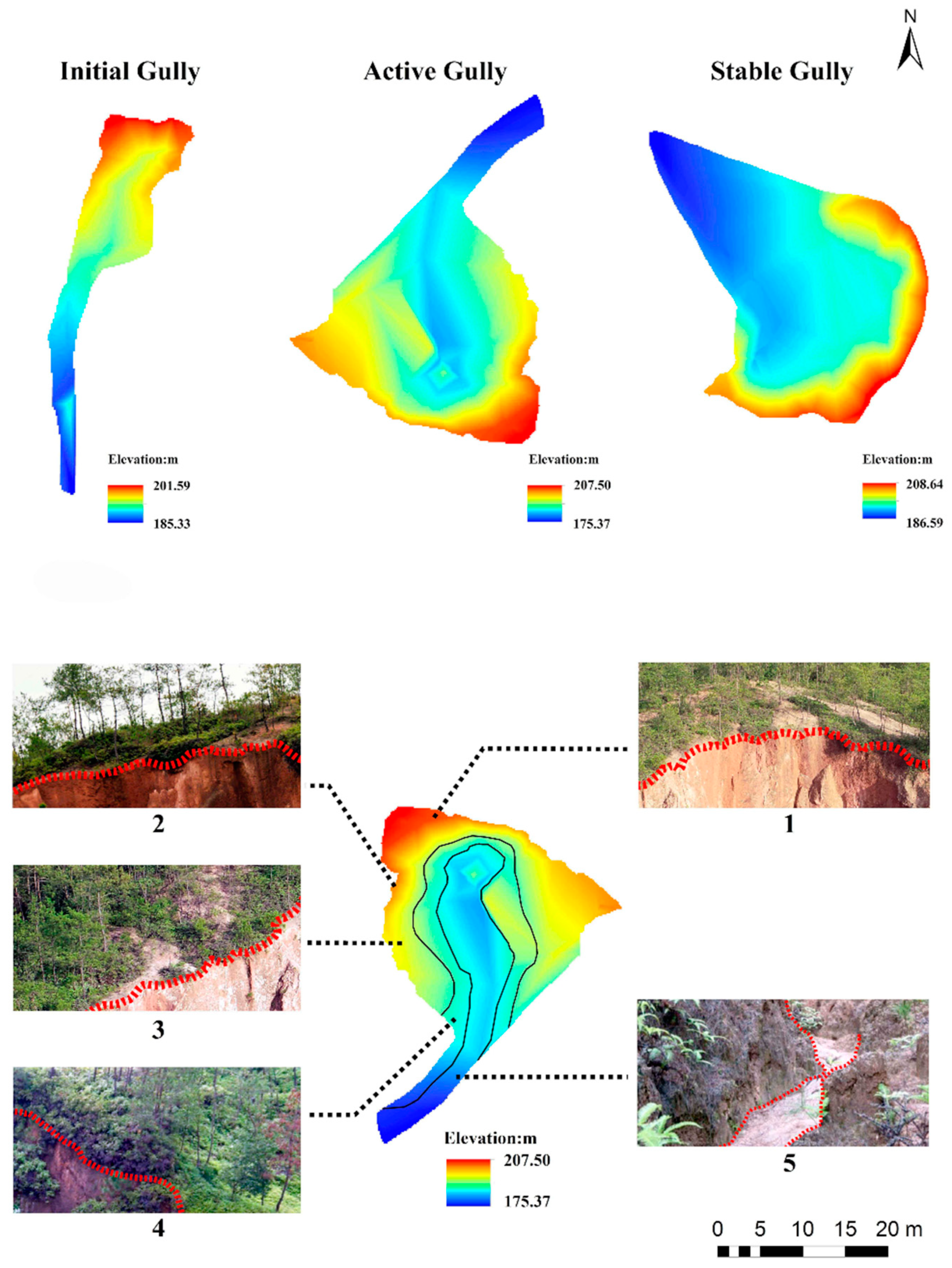
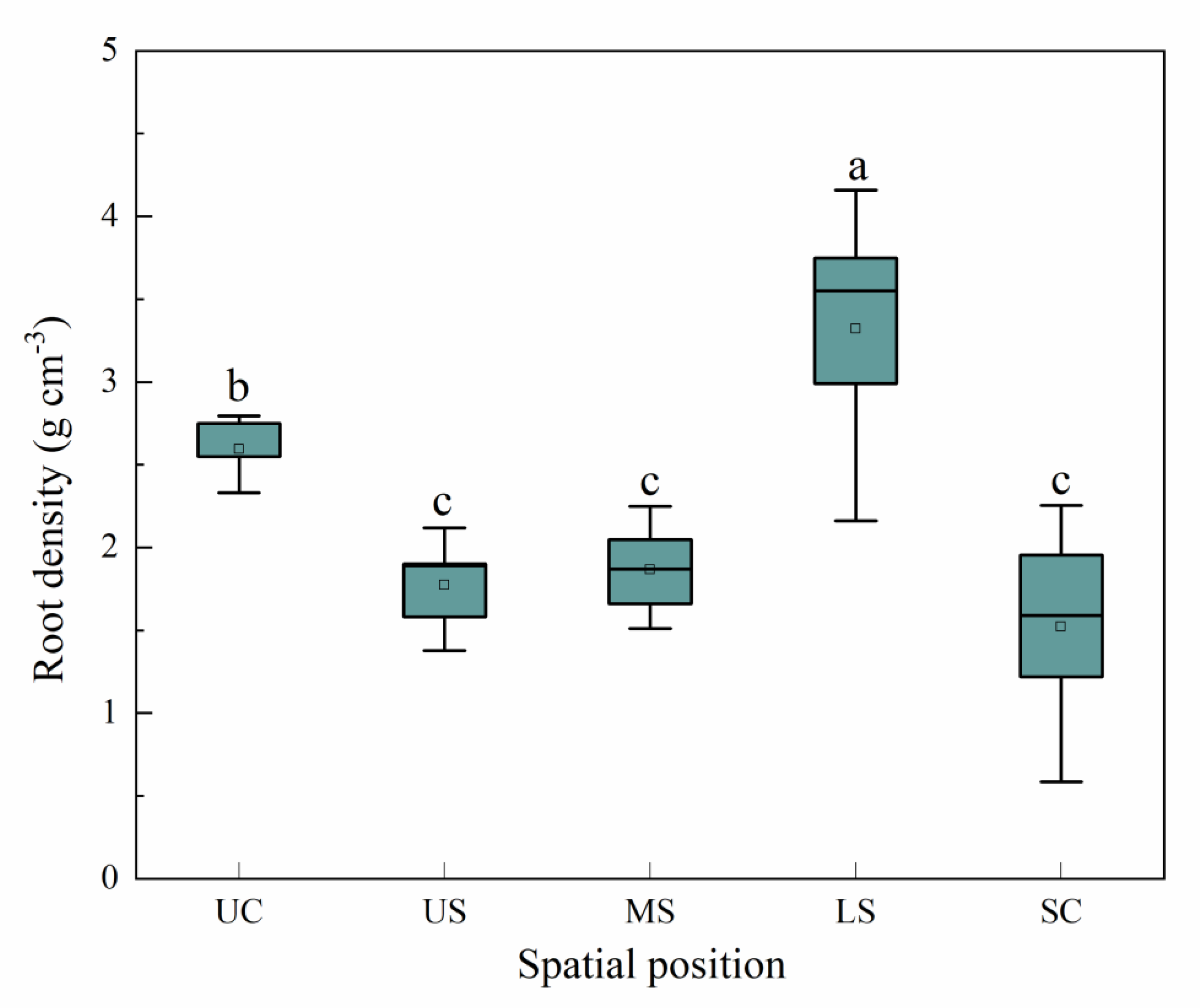
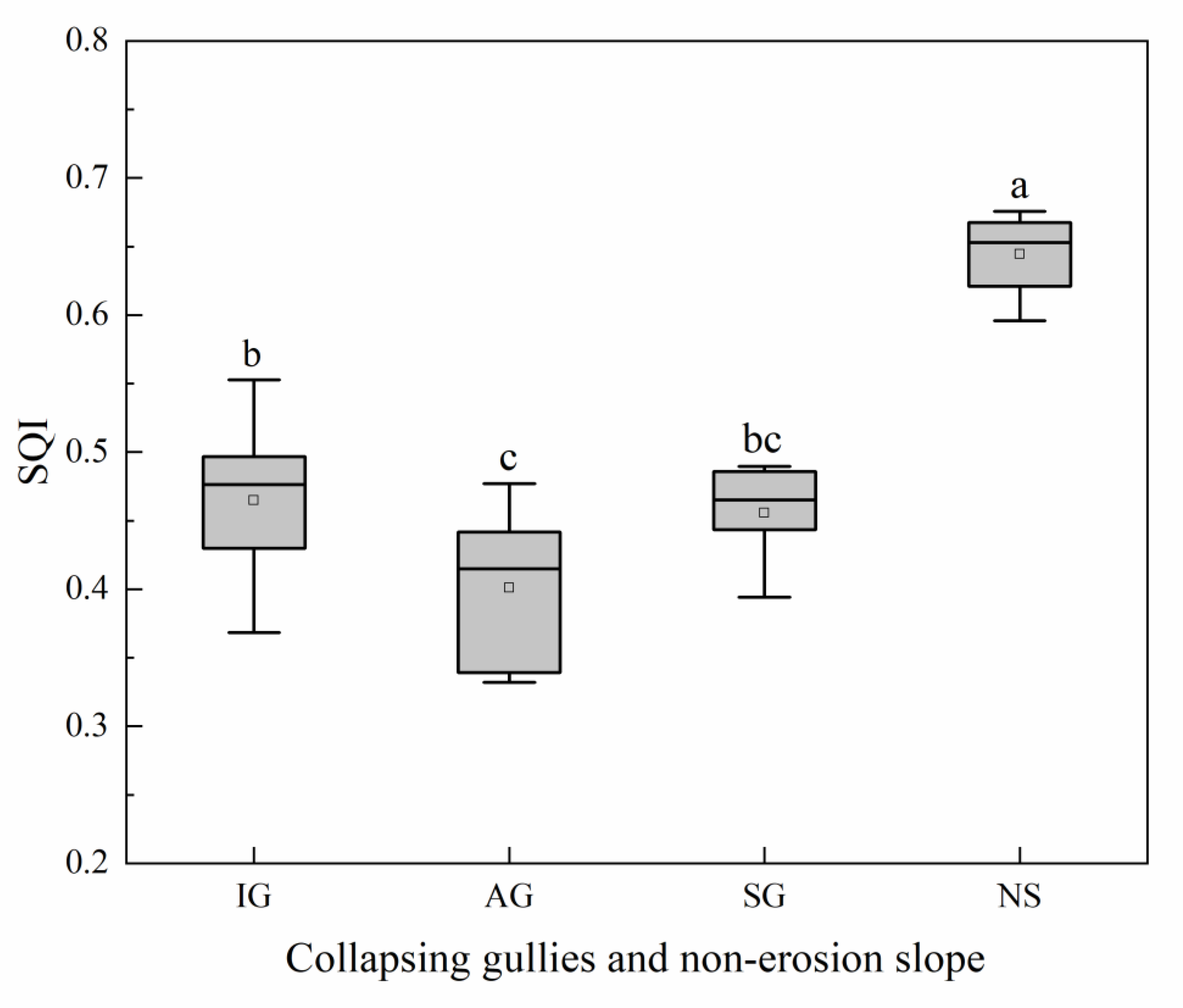
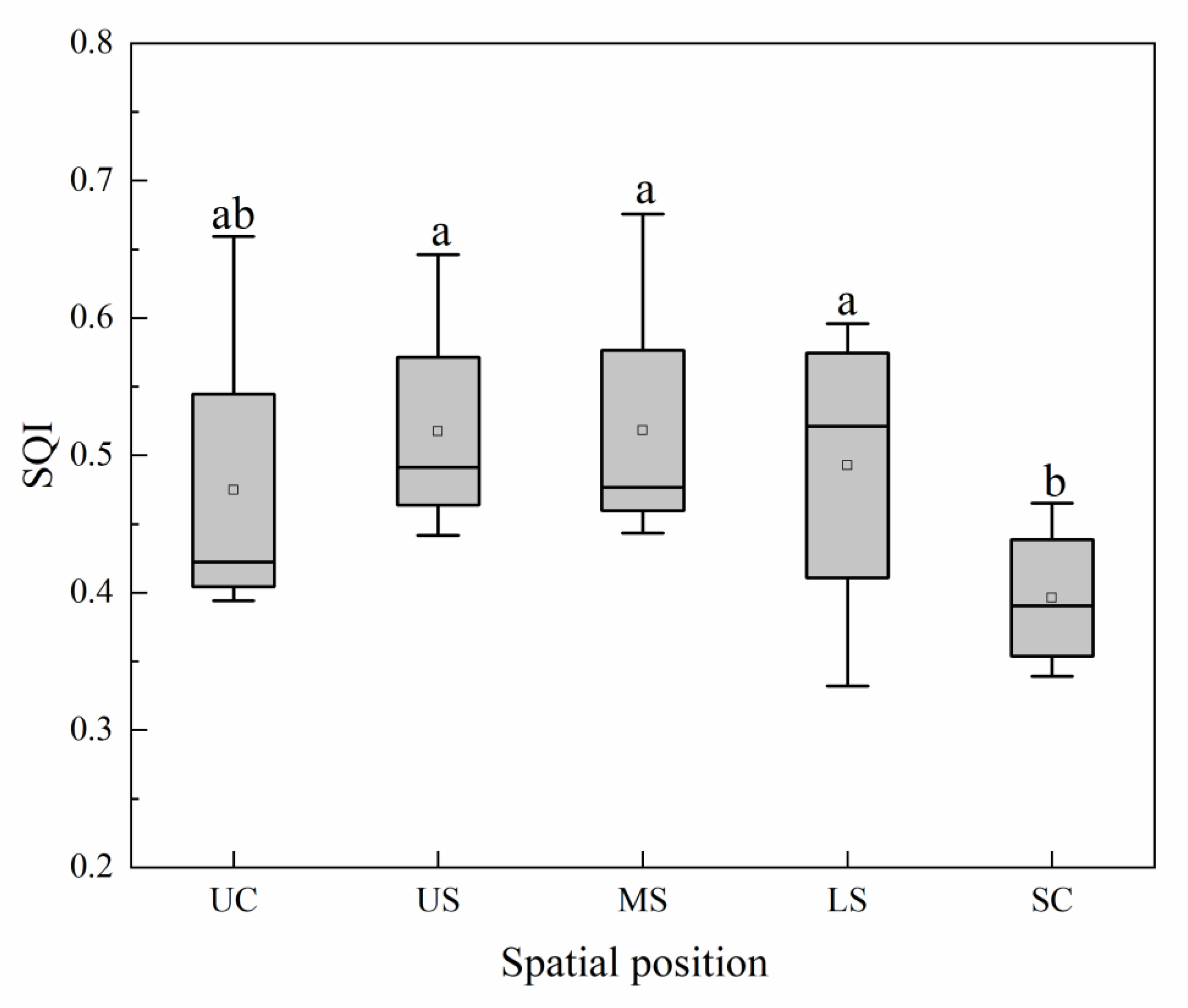

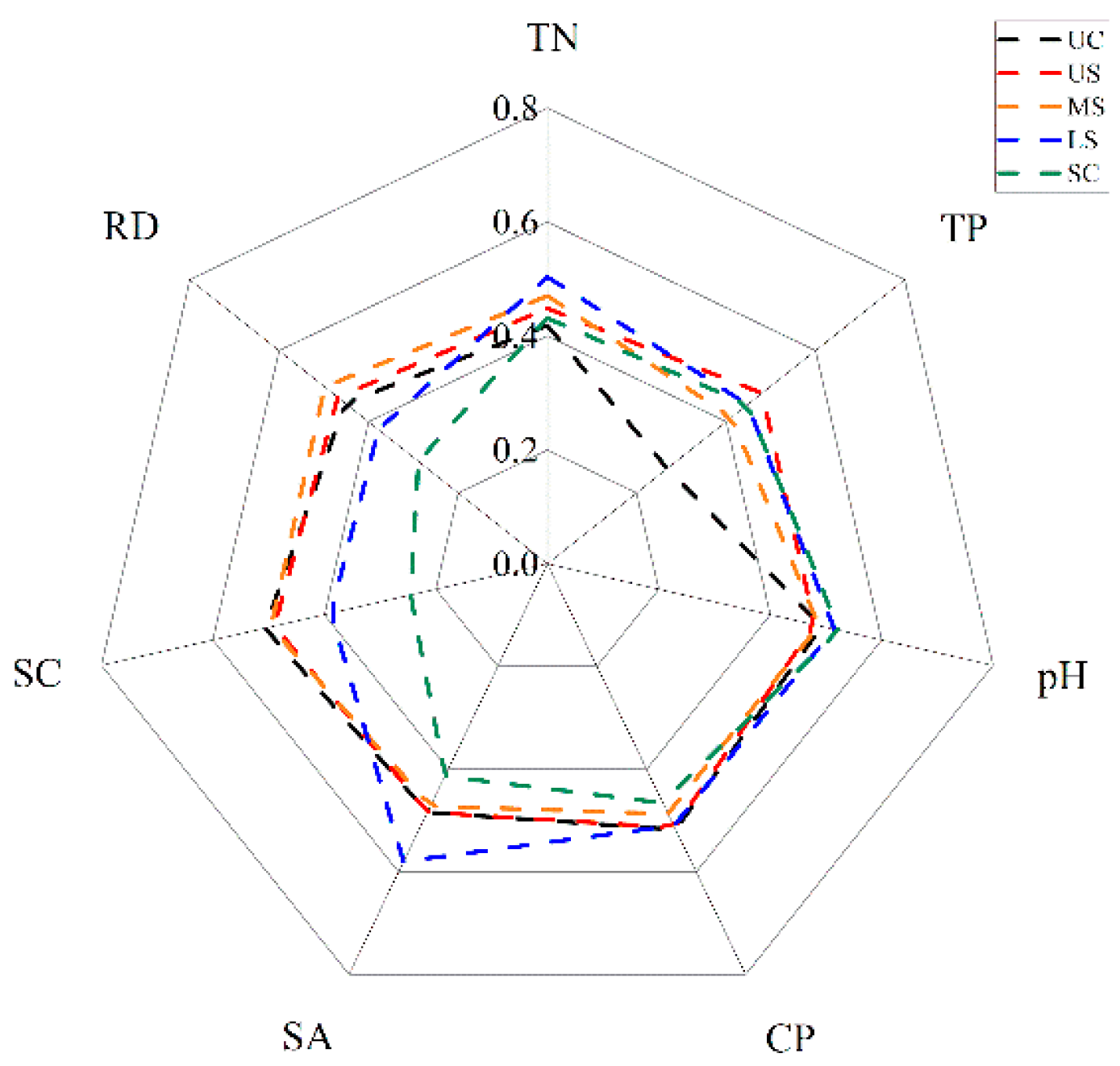
| Code | Longitude and Latitude | Erosion Characteristic | Height of the Gully Wall (m) | Slope Gradient (%) | Length (m) | Maximum Width of the Channel (m) | Coverage of Tree Layer (%) | Coverage of Surface Layer (%) |
|---|---|---|---|---|---|---|---|---|
| IG | 26°11′18″ N; 115°10′37″ E | Initial stage of the collapsing gully; Splash erosion, interrill erosion, rill erosion, headward erosion. | 8.3 | 9–40 | 29.1 | 4.0 | 41 | 76 |
| AG | 26°11′27″ N; 115°10′34″ E | Active stage of the collapsing gully; Splash erosion, interrill erosion, rill erosion, headward erosion, gravity erosion. | 15.0 | 5–31 | 80.1 | 11.2 | 43 | 62 |
| SG | 26°11′37″ N; 115°10′30″ E | Stable stage of the collapsing gully; Splash erosion, interrill erosion, rill erosion. | 10.5 | 12–29 | 51.0 | 7.3 | 59 | 60 |
| NS | 26°11′42″ N; 115°10′47″ E | Non-erosion slope. | — | 12–30 | — | — | 58 | 84 |
| Physical Properties | Code | NS | IG | AG | SG | ||||
|---|---|---|---|---|---|---|---|---|---|
| Mean | Std | Mean | Std | Mean | Std | Mean | Std | ||
| Bulk density (kg m−3) | BD | 1.39 a | 0.09 | 1.33 a | 0.11 | 1.23 a | 0.18 | 1.32 a | 0.08 |
| Capillary porosity (%) | CP | 42.58 a | 2.14 | 44.57 a | 4.61 | 42.96 a | 2.34 | 42.89 a | 1.21 |
| Total porosity (%) | OP | 52.00 ab | 2.66 | 54.06 a | 6.21 | 56.46 a | 5.84 | 56.73 a | 2.82 |
| Clay content (%) | CL | 28.34 a | 2.64 | 24.44 a | 4.00 | 20.58 b | 1.62 | 19.59 b | 1.98 |
| Silt content (%) | SI | 51.56 ab | 4.29 | 54.02 a | 2.41 | 57.26 a | 3.73 | 52.84 ab | 1.91 |
| Sand content (%) | SA | 20.10 b | 2.79 | 21.53 b | 2.01 | 22.16 b | 3.60 | 27.57 a | 1.65 |
| Gravel content (%) | GR | 20.00 a | 5.35 | 23.19 a | 12.75 | 27.78 a | 13.93 | 22.02 a | 8.77 |
| Soil cohesion (kPa) | SC | 14.45 a | 4.53 | 11.81 a | 2.49 | 8.08 b | 1.95 | 8.87 b | 1.36 |
| Hydraulic conductivity (cm min−1) | HC | 0.14 a | 0.01 | 0.15 a | 0.02 | 0.15 a | 0.04 | 0.16 a | 0.02 |
| Chemical Properties | Code | NS | IG | AG | SG | ||||
|---|---|---|---|---|---|---|---|---|---|
| Mean | Std | Mean | Std | Mean | Std | Mean | Std | ||
| Total nitrogen (g kg−1) | TN | 0.36 a | 0.02 | 0.27 c | 0.03 | 0.23 d | 0.01 | 0.32 b | 0.02 |
| Total phosphorus (g kg−1) | TP | 0.10 a | 0.01 | 0.05 bc | 0.01 | 0.06 b | 0.01 | 0.06 b | 0.01 |
| Available nitrogen (mg kg−1) | AN | 59.59 a | 5.04 | 31.44 b | 6.62 | 27.57 b | 8.93 | 50.06 a | 12.12 |
| Available phosphorus (mg kg−1) | AP | 12.83 a | 2.39 | 9.82 b | 1.23 | 8.35 b | 3.02 | 12.67 a | 2.79 |
| Available potassium (mg kg−1) | AK | 58.96 a | 1.85 | 43.71 b | 10.80 | 48.61 b | 7.14 | 53.77 b | 5.50 |
| Soil organic matter (g kg−1) | OM | 13.64 a | 3.72 | 10.61 a | 3.77 | 6.80 c | 2.37 | 9.50 ab | 1.73 |
| pH | pH | 4.30 a | 0.06 | 4.20 b | 0.09 | 4.26 a | 0.32 | 4.49 a | 0.23 |
| Cation exchange capacity (cmol kg−1) | CEC | 8.71 a | 0.71 | 5.73 b | 1.18 | 5.19 b | 1.15 | 6.28 b | 1.06 |
| Physical Properties | ||||||||||
|---|---|---|---|---|---|---|---|---|---|---|
| Treatment | Code | BD | CP | OP | CL | SI | SA | GR | SC | HC |
| Upper catchment | UC | 1.39 a | 42.12 b | 52.82 c | 20.81 a | 55.42 a | 23.77 a | 37.51 a | 10.75 a | 0.15 ab |
| Upper slope | US | 1.39 a | 42.38 ab | 52.26 c | 21.07 a | 54.18 a | 24.75 a | 31.80 a | 9.51 a | 0.16 a |
| Middle slope | MS | 1.35 a | 44.34 a | 58.03 a | 22.71 a | 53.09 ab | 24.20 a | 26.58 ab | 10.95 a | 0.16 a |
| Lower slope | LS | 1.18 b | 42.66 ab | 56.57 ab | 23.48 a | 56.14 a | 20.38 b | 23.32 b | 8.95 a | 0.14 ab |
| Scour channel | SC | 1.16 b | 45.88 a | 59.38 a | 18.16 a | 55.34 a | 26.50 a | 6.37 c | 6.74 ab | 0.18 a |
| Treatment | Chemical Properties | ||||||||
|---|---|---|---|---|---|---|---|---|---|
| Code | TN | TP | AN | AP | AK | OM | pH | CEC | |
| Upper catchment | UC | 0.26 ab | 0.04 ab | 27.76 b | 9.63 ab | 45.54 b | 7.65 ab | 4.26 ab | 5.42 b |
| Upper slope | US | 0.25 ab | 0.07 a | 43.24 a | 7.28 ab | 51.87 a | 8.66 a | 4.07 b | 5.41 b |
| Middle slope | MS | 0.28 a | 0.06 a | 40.94 a | 8.93 ab | 54.44 a | 9.77 a | 4.23 ab | 5.32 b |
| Lower slope | LS | 0.30 a | 0.06 a | 41.46 a | 11.74 a | 54.19 a | 11.05 a | 4.42 a | 5.26 b |
| Scour channel | SC | 0.27 a | 0.06 a | 34.03 ab | 12.16 a | 43.03 b | 7.50 ab | 4.48 a | 7.44 a |
| Statistics Results | PC1 | PC2 | PC3 | PC4 | PC5 |
|---|---|---|---|---|---|
| Eigenvalues | 6.74 | 3.97 | 2.06 | 1.56 | 1.02 |
| Percentage of variance | 35.45 | 20.91 | 10.86 | 8.21 | 5.34 |
| Cumulative percentage | 35.45 | 56.36 | 67.22 | 75.43 | 80.77 |
| Variable loading factor | |||||
| TN | 0.79 | 0.43 | −0.12 | 0.04 | −0.30 |
| TP | 0.86 | 0.14 | −0.05 | −0.11 | 0.28 |
| AN | 0.83 | 0.24 | −0.24 | 0.07 | −0.16 |
| AP | 0.69 | −0.11 | 0.35 | 0.13 | −0.12 |
| AK | 0.61 | 0.22 | −0.47 | −0.11 | −0.18 |
| OM | 0.51 | 0.69 | −0.22 | −0.12 | −0.06 |
| pH | 0.19 | −0.37 | 0.12 | 0.01 | −0.81 |
| CEC | 0.76 | 0.30 | 0.28 | 0.08 | 0.09 |
| BD | −0.01 | 0.62 | −0.57 | 0.05 | 0.15 |
| CP | −0.12 | −0.06 | 0.80 | 0.06 | 0.21 |
| OP | −0.01 | −0.40 | 0.66 | 0.32 | −0.03 |
| CL | 0.27 | 0.79 | −0.05 | −0.47 | 0.12 |
| SI | −0.33 | −0.77 | 0.03 | −0.44 | 0.03 |
| SA | 0.01 | −0.15 | 0.03 | 0.95 | −0.17 |
| GR | −0.50 | 0.12 | −0.65 | −0.18 | 0.23 |
| SC | 0.05 | 0.88 | −0.11 | −0.28 | 0.01 |
| HC | 0.09 | −0.15 | 0.40 | 0.74 | −0.03 |
| RD | 0.29 | 0.79 | −0.32 | −0.16 | 0.08 |
| TN | TP | AN | pH | CEC | CP | CL | SA | SC | RD | |
|---|---|---|---|---|---|---|---|---|---|---|
| Correlation coefficients | ||||||||||
| TN | 1 | |||||||||
| TP | 0.598 | 1 | ||||||||
| AN | 0.859 | 0.67 | 1 | |||||||
| pH | 0.256 | −0.116 | 0.096 | 1 | ||||||
| CEC | 0.616 | 0.677 | 0.57 | 0.076 | 1 | |||||
| CP | −0.209 | −0.168 | −0.191 | −0.09 | 0.054 | 1 | ||||
| CL | 0.484 | 0.478 | 0.337 | −0.363 | 0.385 | −0.211 | 1 | |||
| SA | 0.029 | −0.197 | 0.069 | 0.211 | 0.032 | 0.064 | −0.602 | 1 | ||
| SC | 0.418 | 0.223 | 0.248 | −0.274 | 0.343 | −0.177 | 0.852 | −0.377 | 1 | |
| RD | 0.56 | 0.415 | 0.465 | −0.358 | 0.337 | −0.341 | 0.76 | −0.295 | 0.698 | 1 |
| Correlation sum | 5.029 | 3.944 | 2.976 | 2.372 | 2.151 | 1.793 | 3.214 | 1.672 | 1.698 | 1 |
| Significance level (p) | ||||||||||
| TN | NA | |||||||||
| TP | 0.007 | NA | ||||||||
| AN | 0.000 | 0.002 | NA | |||||||
| pH | 0.290 | 0.635 | 0.696 | NA | ||||||
| CEC | 0.005 | 0.001 | 0.011 | 0.756 | NA | |||||
| CP | 0.390 | 0.492 | 0.433 | 0.715 | 0.827 | NA | ||||
| CL | 0.036 | 0.039 | 0.159 | 0.126 | 0.104 | 0.387 | NA | |||
| SA | 0.905 | 0.420 | 0.779 | 0.386 | 0.896 | 0.795 | 0.006 | NA | ||
| SC | 0.075 | 0.359 | 0.306 | 0.256 | 0.150 | 0.469 | 0.000 | 0.112 | NA | |
| RD | 0.013 | 0.077 | 0.045 | 0.132 | 0.158 | 0.153 | 0.000 | 0.221 | 0.002 | NA |
© 2019 by the authors. Licensee MDPI, Basel, Switzerland. This article is an open access article distributed under the terms and conditions of the Creative Commons Attribution (CC BY) license (http://creativecommons.org/licenses/by/4.0/).
Share and Cite
Feng, S.; Wen, H.; Ni, S.; Wang, J.; Cai, C. Degradation Characteristics of Soil-Quality-Related Physical and Chemical Properties Affected by Collapsing Gully: The Case of Subtropical Hilly Region, China. Sustainability 2019, 11, 3369. https://doi.org/10.3390/su11123369
Feng S, Wen H, Ni S, Wang J, Cai C. Degradation Characteristics of Soil-Quality-Related Physical and Chemical Properties Affected by Collapsing Gully: The Case of Subtropical Hilly Region, China. Sustainability. 2019; 11(12):3369. https://doi.org/10.3390/su11123369
Chicago/Turabian StyleFeng, Shuyue, Hui Wen, Shimin Ni, Junguang Wang, and Chongfa Cai. 2019. "Degradation Characteristics of Soil-Quality-Related Physical and Chemical Properties Affected by Collapsing Gully: The Case of Subtropical Hilly Region, China" Sustainability 11, no. 12: 3369. https://doi.org/10.3390/su11123369
APA StyleFeng, S., Wen, H., Ni, S., Wang, J., & Cai, C. (2019). Degradation Characteristics of Soil-Quality-Related Physical and Chemical Properties Affected by Collapsing Gully: The Case of Subtropical Hilly Region, China. Sustainability, 11(12), 3369. https://doi.org/10.3390/su11123369





